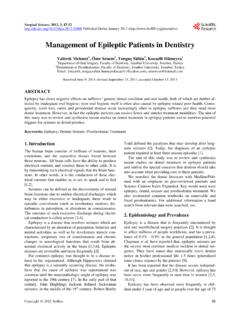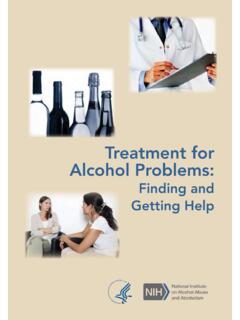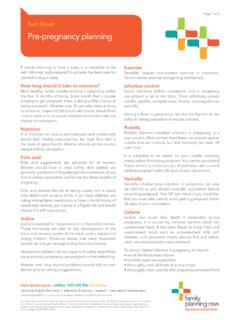Transcription of PALLIATIVE CARE PAIN & SYMPTOM CONTROL …
1 PALLIATIVE care pain & SYMPTOM CONTROL GUIDELINES FOR ADULTS 1 PALLIATIVE care pain & SYMPTOM CONTROL GUIDELINES FOR ADULTSFOR STAFF PROVIDING GENERALIST PALLIATIVE care Greater Manchester and Eastern Cheshire Strategic Clinical Networks Approved by GMMMG: November 2019 Publication date: November 2019 Review date: November 2022 Fifth editionPALLIATIVE care pain & SYMPTOM CONTROL GUIDELINES FOR ADULTS2 INTRODUCTION 4 GENERAL PRINCIPLES OF SYMPTOM MANAGEMENT IN PALLIATIVE care 5 SECTION 1 SPECIFIC SYMPTOMSPAIN MANAGEMENT pain assessment 9 pain management general points 11 WHO Analgesic Ladder 11 Alternative strong opioids 19 Management of opioid side effects 26 Use of naloxone 27 Adjuvant analgesics 29 NAUSEA AND VOMITING
2 32 GASTRO-INTESTINAL OBSTRUCTION 36 CONSTIPATION 40 DIARRHOEA 42 FATIGUE 44 ANOREXIA 45 BREATHLESSNESS 46 COUGH 50 RESPIRATORY SECRETIONS 52 ORAL PROBLEMS 53 HICCUPS 56 DELIRIUM AND CONFUSION 58 ANXIETY 61 DEPRESSION 64 CONTENTSPALLIATIVE care pain & SYMPTOM CONTROL GUIDELINES FOR ADULTS 3 CONTENTSINSOMNIA 66 PALLIATIVE care EMERGENCIES Neutropenic Sepsis 67 Hypercalcaemia 67 Superior vena cava obstruction 69 Metastatic spinal cord compression 70 Cauda Equina Compression 71 Catastrophic haemorrhage 72 CORTICOSTEROIDS 74 SECTION 2 SPECIFIC SITUATIONSRENAL
3 IMPAIRMENT 79 DIABETES 84 MANAGEMENT OF IMPLANTABLECARDIOVERTER DEFIBRILLATORS 86 SYMPTOM MANAGEMENT IN END OF LIFECARE FOR PEOPLE WITH DEMENTIA 88 SECTION 3 - care OF THE DYINGPRIORITIES FOR care OF THE DYING PERSON 93 SYMPTOM MANAGEMENT 94 MAINTAINING HYDRATION 96 SYRINGE PUMPS 98 ALGORITHMS FOR SYMPTOM MANAGEMENT IN THE LAST DAYS OF LIFE Algorithm 1 Patient not already on strong opioids becomes unable to swallow 102 Algorithm 2 Patient taking regular oral morphine becomes unable to swallow 103 Algorithm 3 Patient taking regular oral oxycodone becomes unable to swallow 104 Algorithm 4 Patient using fentanyl or buprenorphine patches becomes unable to swallow 105 Algorithm 5 Terminal restlessness and/or agitation 106 Algorithm 6 Respiratory tract secretions 107 Algorithm 7 Breathlessness 108 Algorithm 8
4 Nausea and/or vomiting 109 Algorithm 9 Patient taking oral anti -epileptics for seizures or seizure prophylaxis 110 SECTION 4 APPENDICESAPPENDIX 1 - OPIOID CONVERSION CHARTS 112 APPENDIX 2 - GENERAL PRINCIPLES AND RESPONSIBILITIES WHEN ASKING FOR ADVICE ABOUT PALLIATIVE care PATIENTS 117 APPENDIX 3 - SPECIALIST MEDICATION PRESCRIBING IN PALLIATIVE AND SUPPORTIVE care 120 SECTION 5 - REFERENCES AND ABBREVIATIONSKEY REFERENCES 123 ABBREVIATIONS 124 PALLIATIVE care pain & SYMPTOM CONTROL GUIDELINES FOR ADULTS4 INTRODUCTIONThis is the fifth edition of the Greater Manchester and Eastern Cheshire Strategic Clinical Networks PALLIATIVE care pain and SYMPTOM CONTROL Guidelines.
5 The level of detail provided is designed to meet the needs of generalist staff caring for PALLIATIVE care patients in all settings hospital, community and care homes. Those working in Specialist PALLIATIVE care are advised to consult the PALLIATIVE care Formulary 6th Edition (PCF6) and local specialist guidelines for more detailed SYMPTOM management information. The guidelines cover the management of particular symptoms and situations which PALLIATIVE care patients may experience, as well as end of life care for patients with an advanced progressive illness. They should be used in conjunction with other national and regional formularies and guidelines, for example: British National Formulary (BNF).
6 Greater Manchester Medicines Management Group Formulary or Central and Eastern Cheshire Medicines Management Team Formulary. Relevant National Institute for Health and care Excellence (NICE) care pain & SYMPTOM CONTROL GUIDELINES FOR ADULTS 5 GENERAL PRINCIPLES OF SYMPTOM MANAGEMENT IN PALLIATIVE CAREGood PALLIATIVE care is not just about supporting someone in the last months, days and hours of life, but about enhancing the quality of life for patients and those close to them at every stage of the disease process from diagnosis onwards. A PALLIATIVE care approach should be considered alongside active disease management from an early stage in the disease process. PALLIATIVE care focuses on the person, not the disease, and applies a holistic approach to meeting the physical, practical, functional, social, emotional and spiritual needs of patients and carers facing progressive illness and bereavement.
7 The guidelines provide information about the general approach to managing a SYMPTOM or situation. However, management must be individualised according to the needs of the particular patient. Effective SYMPTOM management includes: Evaluation the cause of the SYMPTOM , its impact on the patient s life and the treatments tried already. Explanation to the patient and those close to them about the cause of the SYMPTOM and options for treating it. Management individualised to the particular patient. Treat any reversible causes, use non-drug treatments where available, keep drug treatment as simple as possible, seek advice when necessary. Monitoring review the impact of treatment regularly, paying attention to detail.
8 (Ref: Scottish PALLIATIVE care Guidelines, SYMPTOM Management in Advanced Cancer)SEEKING SPECIALIST ADVICET hroughout the guidelines there are numerous recommendations to seek specialist advice. For advice or further information, please contact your local hospice or Specialist PALLIATIVE care of medications outside their marketing authorisation (formerly known as product licence).Many drugs are used in PALLIATIVE care outside their marketing authorisation at the prescriber s discretion. The inclusion of a drug, dose or treatment in these guidelines does not absolve the prescriber of their personal responsibility in providing treatment that they are confident with, can justify and that is tailored to the individual patient.
9 For details of authorised indications see the current BNF. PALLIATIVE care pain & SYMPTOM CONTROL GUIDELINES FOR ADULTS6 Contributors to this edition: Dr Aruna HodgsonClinical Lead, Greater Manchester and Eastern Cheshire Strategic Clinical Networks PALLIATIVE care pain and SYMPTOM CONTROL Guidelines Update Task and Finish GroupDr Debbie AlexanderMedical Director, East Cheshire HospiceDr Stephanie LippettSenior Hospice Dr (Community), Springhill HospiceElaine ParkinQuality Improvement Programme Manager, PALLIATIVE and End of Life care , Greater Manchester and Eastern Cheshire Strategic Clinical NetworksJennie PickardPalliative care Pharmacist, St Ann s Hospice, Heald Green and Manchester University NHS Foundation TrustAnna SwiftSenior Assistant Director Medicines Management, NHS Wigan Borough Clinical Commissioning GroupDr David WatermanPalliative and End of Life care Clinical Lead, Greater Manchester and Eastern Cheshire Strategic Clinical NetworksAuthorised by: Greater Manchester and Eastern Cheshire Strategic Clinical Networks PALLIATIVE and End of Life care Advisory.
10 All colleagues working in Specialist PALLIATIVE care who have contributed to previous editions of the care pain & SYMPTOM CONTROL GUIDELINES FOR ADULTS 7 PALLIATIVE care pain & SYMPTOM CONTROL GUIDELINES FOR ADULTS8 SECTION 1 SPECIFIC SYMPTOMS PALLIATIVE care pain & SYMPTOM CONTROL GUIDELINES FOR ADULTS 9 PAIN1. pain assessment Good assessment is vital for effective management. Many PALLIATIVE care patients have more than one pain . Assess each pain separately and if possible identify the likely cause of the pain . pain may be constant or intermittent (breakthrough pain ).Ask about: site and radiation - a body diagram can help character - a list of descriptive words may help onset, intensity and severity - a rating scale can help a numerical score where 0 = no pain and 10 = severe/overwhelming or a simple verbal rating scale none/mild/moderate/severe timing and duration exacerbating factors relieving factors, including medication effect on function, sleep and mood response to previous medication and treatment associated symptoms.














